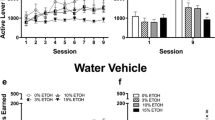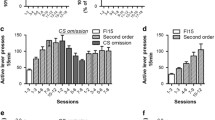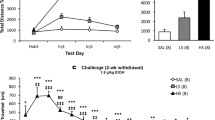Abstract
Rationale
The development of mouse models of ethanol consumption and ethanol-seeking behavior is of particular importance in understanding the underlying mechanisms of drug abuse because these models can enable an analysis of an effect of specific genotype on drug-seeking behavior and the interaction of potential therapeutics with genotype. However, there are some limitations with present models, notably the inability to examine appetitive and consummatory behavior separately.
Materials and methods
In the present study, C57BL/6 mice were trained to self-administer 10% ethanol in a modified operant protocol that allowed a clear delineation of consummatory and appetitive phases. The utility of this procedure was confirmed with the use of the metabotropic glutamate 5 (mGlu5) receptor antagonist 3-[(2-methyl-1,3-thiazol-4-yl)ethynyl]-pyridine (MTEP).
Results
Limited-access consumption during the dark phase of the light–dark cycle with intermittent access (every second or third day) led to a high level of consumption by the mice. MTEP caused a dose-dependent decrease in both the consumption of ethanol and the appetitive response for ethanol. Furthermore, this effect was unrelated to any effect of MTEP on locomotor activity.
Conclusions
The model provides a useful paradigm for examining both the appetitive and consummatory phases of ethanol consumption in mice; furthermore, the data indicate mGlu5 receptors are involved in both phases.




Similar content being viewed by others
References
Anderson JJ, Rao SP, Rowe B, Giracello DR, Holtz G, Chapman DF, Tehrani L, Bradbury MJ, Cosford ND, Varney MA (2002) [3H]Methoxymethyl-3-[(2-methyl-1,3-thiazol-4-yl)ethynyl]pyridine binding to metabotropic glutamate receptor subtype 5 in rodent brain: in vitro and in vivo characterization. J Pharmacol Exp Ther 303:1044–1051
Aoki T, Narita M, Shibasaki M, Suzuki T (2004) Metabotropic glutamate receptor 5 localized in the limbic forebrain is critical for the development of morphine-induced rewarding effect in mice. Eur J Neurosci 20:1633–1638
Bäckstrom P, Bachteler D, Koch S, Hyytia P, Spanagel R (2004) mGluR5 antagonist MPEP reduces ethanol-seeking and relapse behavior. Neuropsychopharmacology 29:921–928
Balschun D, Wetzel W (2002) Inhibition of mGluR5 blocks hippocampal LTP in vivo and spatial learning in rats. Pharmacol Biochem Behav 73:375–380
Boyce-Rustay JM, Risinger FO (2003) Dopamine D3 receptor knockout mice and the motivational effects of ethanol. Pharmacol Biochem Behav 75:373–379
Brodkin J, Bradbury M, Busse C, Warren N, Bristow LJ, Varney MA (2002a) Reduced stress-induced hyperthermia in mGluR5 knockout mice. Eur J Neurosci 16:2241–2244
Brodkin J, Busse C, Sukoff SJ, Varney MA (2002b) Anxiolytic-like activity of the mGluR5 antagonist MPEP a comparison with diazepam and buspirone. Pharmacol Biochem Behav 73:359–366
Busse CS, Brodkin J, Tattersall D, Anderson JJ, Warren N, Tehrani L, Bristow LJ, Varney MA, Cosford ND (2004) The behavioral profile of the potent and selective mGlu5 receptor antagonist 3-[(2-methyl-1,3-thiazol-4-yl)ethynyl]pyridine (MTEP) in rodent models of anxiety. Neuropsychopharmacology 29:1971–1979
Chiamulera C, Epping-Jordan MP, Zocchi A, Marcon C, Cottiny C, Tacconi S, Corsi M, Orzi F, Conquet F (2001) Reinforcing and locomotor stimulant effects of cocaine are absent in mGluR5 null mutant mice. Nat Neurosci 4:873–874
Conn PJ, Pin JP (1997) Pharmacology and functions of metabotropic glutamate receptors. Annu Rev Pharmacol Toxicol 37:205–237
Cosford ND, Tehrani L, Roppe J, Schweiger E, Smith ND, Anderson J, Bristow L, Brodkin J, Jiang X, McDonald I, Rao S, Washburn M, Varney MA (2003) 3-[(2-Methyl-1,3-thiazol-4-yl)ethynyl]-Pyridine: a potent and highly selective metabotropic glutamate subtype 5 receptor antagonist with anxiolytic activity. J Med Chem 46:204–206
Cowen MS, Adams C, Kraehenbuehl T, Vengeliene V, Lawrence AJ (2005a) The acute anti-craving effect of acamprosate in alcohol-preferring rats is associated with modulation of the mesolimbic dopamine system. Addict Biol 10:233–242
Cowen MS, Djouma E, Lawrence AJ (2005b) The metabotropic glutamate 5 receptor antagonist 3-[(2-methyl-1,3-thiazol-4-yl)ethynyl]-pyridine reduces ethanol self-administration in multiple strains of alcohol-preferring rats and regulates olfactory glutamatergic systems. J Pharmacol Exp Ther 315:590–600
Czachowski CL, Samson HH (2002) Ethanol- and sucrose-reinforced appetitive and consummatory responding in HAD1, HAD2, and P rats. Alcohol Clin Exp Res 26:1653–1661
Czachowski CL, Legg BH, Samson HH (2001) Effects of acamprosate on ethanol-seeking and self-administration in the rat. Alcohol Clin Exp Res 25:344–350
Elmer GI, Pieper JO, Rubinstein M, Low MJ, Grandy DK, Wise RA (2002) Failure of intravenous morphine to serve as an effective instrumental reinforcer in dopamine D2 receptor knock-out mice. J Neurosci 22:RC224
Finn DA, Belknap JK, Cronise K, Yoneyama N, Murillo A, Crabbe JC (2005) A procedure to produce high alcohol intake in mice. Psychopharmacology (Berl) 178:471–480
Freedland CS, Sharpe AL, Samson HH, Porrino LJ (2001) Effects of SR141716A on ethanol and sucrose self-administration. Alcohol Clin Exp Res 25:277–282
Grahame NJ, Low MJ, Cunningham CL (1998) Intravenous self-administration of ethanol in beta-endorphin-deficient mice. Alcohol Clin Exp Res 22:1093–1098
Hermans E, Challiss RA (2001) Structural, signalling and regulatory properties of the group I metabotropic glutamate receptors: prototypic family C G-protein-coupled receptors. Biochem J 359:465–484
Hodge CW, Miles MF, Sharko AC, Stevenson RA, Hillmann JR, Lepoutre V, Besheer J, Schroeder JP (2006) The mGluR5 antagonist MPEP selectively inhibits the onset and maintenance of ethanol self-administration in C57BL/6J mice. Psychopharmacology (Berl) 183:429–438
Kashkin VA, Bagrov AY, Fedorova OV, Bagrov YY, Agalakova NI, Patkina NA, Zvartau EE (2002) Marinobufagenin (MBG) suppression of ethanol-seeking behavior is associated with inhibition of brain cortex Na/K-ATPase in mice. Eur Neuropsychopharmacol 12:217–223
Kenny PJ, Boutrel B, Gasparini F, Koob GF, Markou A (2005) Metabotropic glutamate 5 receptor blockade may attenuate cocaine self-administration by decreasing brain reward function in rats. Psychopharmacology (Berl) 179:247–254
Klodzinska A, Tatarczynska E, Chojnacka-Wojcik E, Nowak G, Cosford ND, Pilc A (2004) Anxiolytic-like effects of MTEP, a potent and selective mGlu5 receptor antagonist does not involve GABAA signaling. Neuropharmacology 47:342–350
Lawrence AJ, Cowen MS, Yang H-J, Chen F, Oldfield B (2006) The orexin system regulates alcohol-seeking in rats. Br J Pharmacol 148:752–759
Liang JH, Chen F, Krstew E, Cowen MS, Carroll FY, Crawford D, Beart PM, Lawrence AJ (2006) The GABAB receptor allosteric modulator CGP7930, like baclofen, reduces operant self-administration of ethanol in alcohol-preferring rats. Neuropharmacology 50:632–639
Lu YM, Jia Z, Janus C, Henderson JT, Gerlai R, Wojtowicz JM, Roder JC (1997) Mice lacking metabotropic glutamate receptor 5 show impaired learning and reduced CA1 long-term potentiation (LTP) but normal CA3 LTP. J Neurosci 17:5196–5205
McGeehan AJ, Olive MF (2003) The mGluR5 antagonist MPEP reduces the conditioned rewarding effects of cocaine but not other drugs of abuse. Synapse 47:240–242
Middaugh LD, Kelley BM (1999) Operant ethanol reward in C57BL/6 mice: influence of gender and procedural variables. Alcohol 17:185–194
Middaugh LD, Kelley BM, Groseclose CH, Cuison ER Jr (2000a) Delta-opioid and 5-HT3 receptor antagonist effects on ethanol reward and discrimination in C57BL/6 mice. Pharmacol Biochem Behav 65:145–154
Middaugh LD, Lee AM, Bandy AL (2000b) Ethanol reinforcement in nondeprived mice: effects of abstinence and naltrexone. Alcohol Clin Exp Res 24:1172–1179
Mittleman G, Van Brunt CL, Matthews DB (2003) Schedule-induced ethanol self-administration in DBA/2J and C57BL/6J mice. Alcohol Clin Exp Res 27:918–925
Navarro M, Carrera MR, Fratta W, Valverde O, Cossu G, Fattore L, Chowen JA, Gomez R, del Arco I, Villanua MA, Maldonado R, Koob GF, Rodriguez de Fonseca F (2001) Functional interaction between opioid and cannabinoid receptors in drug self-administration. J Neurosci 21:5344–5350
Olive MF, Mehmert KK, Messing RO, Hodge CW (2000) Reduced operant ethanol self-administration and in vivo mesolimbic dopamine responses to ethanol in PKC epsilon-deficient mice. Eur J Neurosci 12:4131–4140
Olive MF, McGeehan AJ, Kinder JR, McMahon T, Hodge CW, Janak PH, Messing RO (2005) The mGluR5 antagonist 6-methyl-2-(phenylethynyl)pyridine decreases ethanol consumption via a protein kinase C epsilon-dependent mechanism. Mol Pharmacol 67:349–355
Paterson NE, Semenova S, Gasparini F, Markou A (2003) The mGluR5 antagonist MPEP decreased nicotine self-administration in rats and mice. Psychopharmacology (Berl) 167:257–264
Pilc A, Klodzinska A, Branski P, Nowak G, Palucha A, Szewczyk B, Tatarczynska E, Chojnacka-Wojcik E, Wieronska JM (2002) Multiple MPEP administrations evoke anxiolytic- and antidepressant-like effects in rats. Neuropharmacology 43:181–187
Rhodes JS, Best K, Belknap JK, Finn DA, Crabbe JC (2005) Evaluation of a simple model of ethanol drinking to intoxication in C57BL/6J mice. Physiol Behav 84:53–63
Risinger FO, Doan AM, Vickrey AC (1999) Oral operant ethanol self-administration in 5-HT1b knockout mice. Behav Brain Res 102:211–215
Risinger FO, Freeman PA, Rubinstein M, Low MJ, Grandy DK (2000) Lack of operant ethanol self-administration in dopamine D2 receptor knockout mice. Psychopharmacology (Berl) 152:343–350
Roberts AJ, McDonald JS, Heyser CJ, Kieffer BL, Matthes HW, Koob GF, Gold LH (2000) mu-Opioid receptor knockout mice do not self-administer alcohol. J Pharmacol Exp Ther 293:1002–1008
Roberts AJ, Gold LH, Polis I, McDonald JS, Filliol D, Kieffer BL, Koob GF (2001) Increased ethanol self-administration in delta-opioid receptor knockout mice. Alcohol Clin Exp Res 25:1249–1256
Ryabinin AE, Galvan-Rosas A, Bachtell RK, Risinger FO (2003) High alcohol/sucrose consumption during dark circadian phase in C57BL/6J mice: involvement of hippocampus, lateral septum and urocortin-positive cells of the Edinger–Westphal nucleus. Psychopharmacology (Berl) 165:296–305
Samson HH, Pfeffer AO, Tolliver GA (1988) Oral ethanol self-administration in rats: models of alcohol-seeking behavior. Alcohol Clin Exp Res 12:591–598
Samson HH, Slawecki CJ, Sharpe AL, Chappell A (1998) Appetitive and consummatory behaviors in the control of ethanol consumption: a measure of ethanol seeking behavior. Alcohol Clin Exp Res 22:1783–1787
Samson HH, Sharpe AL, Denning C (1999) Initiation of ethanol self-administration in the rat using sucrose substitution in a sipper-tube procedure. Psychopharmacology (Berl) 147:274–279
Schroeder JP, Overstreet DH, Hodge CW (2005) The mGluR5 antagonist MPEP decreases operant ethanol self-administration during maintenance and after repeated alcohol deprivations in alcohol-preferring (P) rats. Psychopharmacology (Berl) 179:262–270
Sharpe AL, Samson HH (2001) Effect of naloxone on appetitive and consummatory phases of ethanol self-administration. Alcohol Clin Exp Res 25:1006–1011
Stephens DN, Pistovcakova J, Worthing L, Atack JR, Dawson GR (2005) Role of GABAA alpha5-containing receptors in ethanol reward: the effects of targeted gene deletion, and a selective inverse agonist. Eur J Pharmacol 526:240–250
Szumlinski KK, Dehoff MH, Kang SH, Frys KA, Lominac KD, Klugmann M, Rohrer J, Griffin W 3rd, Toda S, Champtiaux NP, Berry T, Tu JC, Shealy SE, During MJ, Middaugh LD, Worley PF, Kalivas PW (2004) Homer proteins regulate sensitivity to cocaine. Neuron 43:401–413
Tatarczynska E, Klodzinska A, Chojnacka-Wojcik E, Palucha A, Gasparini F, Kuhn R, Pilc A (2001) Potential anxiolytic- and antidepressant-like effects of MPEP, a potent, selective and systemically active mGlu5 receptor antagonist. Br J Pharmacol 132:1423–1430
Acknowledgement
This work was supported by the National Health and Medical Research Council, Australia (program grant 236805), of which AJL is a Senior Research Fellow.
Author information
Authors and Affiliations
Corresponding author
Rights and permissions
About this article
Cite this article
Cowen, M.S., Krstew, E. & Lawrence, A.J. Assessing appetitive and consummatory phases of ethanol self-administration in C57BL/6J mice under operant conditions: regulation by mGlu5 receptor antagonism. Psychopharmacology 190, 21–29 (2007). https://doi.org/10.1007/s00213-006-0583-0
Received:
Accepted:
Published:
Issue Date:
DOI: https://doi.org/10.1007/s00213-006-0583-0




